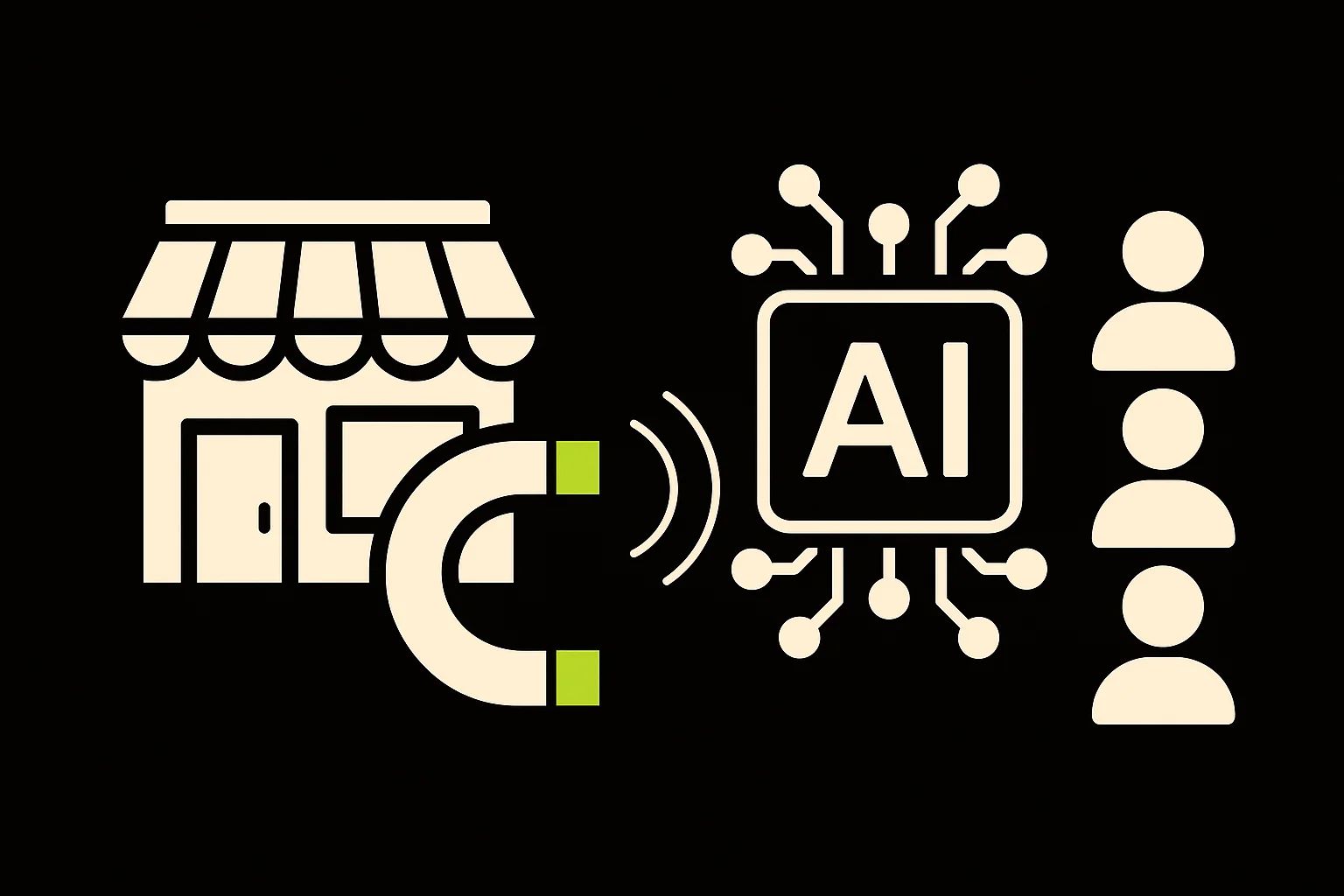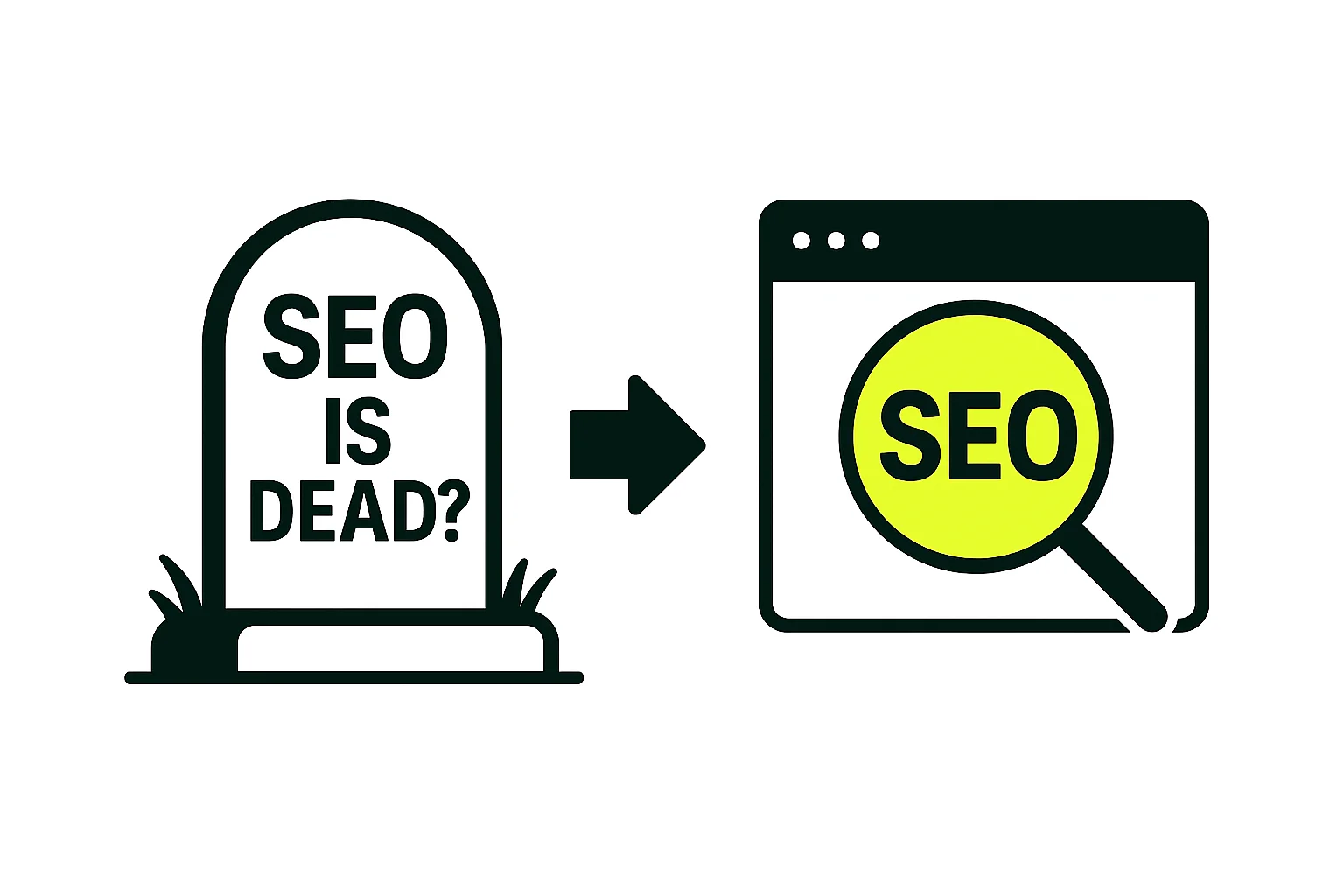Let’s clear the air real quick.
SEO isn’t dead.
But the way most businesses use it?
Yeah — that part should’ve been buried years ago.
If you’re a small business owner in Vancouver, WA or Portland, OR, there’s a good chance you’ve heard the phrase “SEO doesn’t work anymore.”
You might’ve even said it.
And hey — if all you’ve seen are outdated blogs, clunky websites, and a bunch of agencies pitching you “ranking reports,” then fair enough.
I’d be skeptical too.
But here’s what we’ve learned from working with dozens of local businesses across the PNW:
The ones who think SEO is dead… are the ones stuck using it like it’s still 2010.
Because SEO isn’t just alive — it’s evolving.
It’s sharper, more human, and more local than ever.
And if you’re still ignoring it?
Your competitor across town isn’t.
And their phone’s probably ringing a little more than yours.
Let’s show you what’s actually working in 2025 — and how you can finally stop wasting time on outdated strategies.

What Actually Died: Keyword Cramming, Link Farms, and Cheap Tricks
Let’s put some respect on the funeral playlist.
The part of SEO that did die?
It deserved it.
Back in the day, you could slap the word “chiropractor” onto your homepage 87 times, buy some sketchy backlinks from a site selling bulk sunglasses in Belarus, and watch your rankings climb.
Now?
Google sees that and goes, “Yeah… no.”
And sends your site straight to the digital dumpster behind page 7.
If you’re still clinging to:
- Exact match domains (e.g., best-dentist-in-portland-cheap.biz)
- Spammy backlinks that you “earned” by paying someone on Facebook $99
- Meta descriptions copied from the first thing ChatGPT spit out
Then yes — your SEO is dead.
But not because SEO died.
Because the strategy is stuck in the past, like a Blockbuster membership card.
This matters for Vancouver and Portland businesses especially.
Local search is smarter now. Google cares about relevance, authority, and whether your business looks legit in your own backyard.
And if your website still reads like it was built during the MySpace era?
It’s not Google’s fault you’re invisible.
It’s yours.

Why Your Competitor Is Ranking (And You’re Not)
You ever Google your service and see that one business pop up — the one you secretly know you’re better than?
Their website’s fine.
Their reviews are okay.
But somehow, they’re everywhere.
Let’s talk about it.
They’re not better.
They’re just playing the game. And you’re still waiting for someone to explain the rules.
Here’s what they’re probably doing right (and what you might not be):
- They’re publishing content regularly. Even simple stuff — FAQs, case studies, “best of” local lists. Google sees them as active and engaged.
- Their pages are actually optimized. Titles, headers, internal links. They’ve got a strategy. You’ve got a homepage and a dream.
- Their site loads fast. On mobile too. And yours? Feels like it’s buffering over dial-up.
- They’re locally dialed-in. Their Google Business Profile is fully optimized. They respond to reviews. They use local terms in their content — not just “dentist,” but “Hawthorne dentist” or “Vancouver family dentist near Columbia Tech Center.”
It’s not that they’re spending big money.
It’s that they’re spending smart.
And in places like Portland and Vancouver, where local search is often the first touchpoint with a customer?
Showing up = winning.
This is where SEO stops being a “maybe someday” and becomes a “right now.”
Because if your site’s not pulling weight… you’re not just invisible —you’re leaving the door wide open for the guy across town to eat your leads.

Trying to “trick” Google instead of just being helpful.
Write like a human, focus local, and show up consistently — that’s it.
Local SEO Isn’t Optional. It’s Oxygen.
This isn’t just about “ranking.”
It’s about existing where your customers are looking.
And in Vancouver, WA or Portland, OR, people search local first.
“Near me” has become the new “hello.”
If you’re not showing up when someone Googles your service + your neighborhood?
You’re not just missing traffic —you’re missing trust.
Local SEO is about:
- Relevance. Your content needs to reflect the city you’re in.
- Proximity. Google’s not showing your downtown Portland business to someone in Camas unless it makes sense.
- Reputation. Reviews matter. A lot. Especially the way you respond to them.
Want proof?
A local HVAC company we worked with in Vancouver added city-specific service pages, optimized their GBP, and started posting hyper-local blog content.
Result?
They went from a ghost town on Google Maps to 4x inbound calls in 90 days.
You don’t need to be famous.
You need to be everywhere your customers are already looking.

It’s simple, repeatable, and built to rank.
This playbook gives you the exact steps you need to rank. (Click the image to download.)
The Truth About AI: It’s Not Smarter Than You — It’s Just Faster
Let’s be honest — the buzz around AI is deafening.
Everyone’s promising faster blogs, more traffic, and magical robots that “do your marketing for you while you sleep.”
Cool story.
But if you’re a business owner in Portland or Vancouver, here’s what you really need to know:
AI doesn’t replace strategy.
It replaces wasted time — if you know how to use it.
At Local Pulse, we don’t hand over the keys to some content bot and hope for the best.
We use AI to speed up what already works.
For example:
- A Portland chiropractor was spending hours trying to write weekly blog content. We used ChatGPT to generate drafts, then layered in their brand voice and local insights. Result: organic traffic tripled in two months.
- A Vancouver home remodeling company used AI to brainstorm FAQ content. We took those ideas, localized them, and turned them into service pages that now rank top 3 in their city.
- A PDX dentist was struggling to stand out online. We used AI to analyze their competitors’ reviews, extract pain points, and rewrite their homepage with messaging that actually hit. Result? 42% increase in leads.
But here’s the part everyone skips:
If you don’t know your customer — their fears, their language, their expectations — then AI just becomes another shiny toy producing polished nothing.
That’s why copywriting still matters.
That’s why audience insight still wins.
That’s why you’re still the most valuable strategist in the room.
Use AI to amplify your clarity — not hide the fact that you don’t have any.
Because when done right?
It’s not about cutting corners.
It’s about cutting through the BS.

Local Businesses Using AI the Right Way (Case Studies That Hit)
We’ve already said it — AI won’t save bad marketing.
But when paired with strategy? It’s a cheat code.
Here’s what it actually looks like on the ground in Portland and Vancouver:
Case Study 1: A Portland Dental Practice That Found Its Voice
Dr. Brenner had a problem.
Her practice was getting traffic, but no one was converting. Her homepage sounded like it had been ghostwritten by a dental textbook.
We used AI to:
- Analyze competitor reviews across Portland
- Pull emotional language from real patients (“finally pain-free,” “felt heard,” “nervous about dentists”)
- Rebuild the homepage copy with warmth, clarity, and actual empathy
Now her bounce rate is down 37%, and calls are up 58% month-over-month.
AI didn’t make her a better dentist — it made her messaging finally match what patients already loved about her.
Case Study 2: Vancouver Contractor Gets Found, Fast
Greg, a general contractor based in Vancouver, WA, came to us with a common story: “We get referrals, but no one finds us online.”
He had great work, solid reviews, zero visibility.
Here’s what we did using AI:
- Built service-area landing pages in less than a week
- Used ChatGPT to create outline drafts, then rewrote them with hyper-local terms (mentioning neighborhoods, landmarks, even bridges)
- Repurposed those blogs into Google Business posts and FAQs
Within 60 days, they were ranking for “kitchen remodel Vancouver WA” and “garage conversion Camas” — and started getting form fills from Google for the first time ever.
Case Study 3: Portland Salon Turns Blog Traffic into Bookings
Marina ran a boutique hair salon in NE Portland. She loved the idea of content marketing, hated the execution.
We helped her:
- Use AI to generate monthly blog outlines around high-intent local keywords
- Optimize the posts for “best curly hair salon Portland” and related queries
- Pull snippets from each post to fuel her email newsletter and GBP updates
It wasn’t viral — it was consistent.
In 90 days, her organic traffic doubled.
Her appointment calendar filled faster. And she finally stopped dreading blog days.
AI isn’t the hero here.
It’s the sidekick — the Robin to your Batman.
But only if you’re willing to drive the story.

Don’t Just Prompt — Train Your AI Like It’s on Payroll
Before you ask AI to “write a blog,” do this:
Imagine hiring a copywriter who doesn’t know your business, your customers, or your city — and then telling them to “write something good.”
That’s how most people use ChatGPT.
And that’s exactly why they get bland, off-brand, local-SEO-useless garbage.
Here’s how to actually get value out of AI — the way we do it at Local Pulse when we’re writing for clients in Vancouver or Portland.
Step 1: Introduce Your Business Like You’re Meeting a Consultant
Before you ask ChatGPT to generate anything, give it a complete profile. Like this:
Prompt Example:
“Hi ChatGPT. My name is Mark, and I run a chiropractic clinic called Centerlink Chiro.
We’re located in Vancouver, WA and most of our patients come from surrounding neighborhoods like Orchards, Five Corners, and Salmon Creek.
We specialize in auto accident recovery, sports injuries, and chronic back pain.
We accept both cash and insurance, and we currently get most of our patients from Google Search, referrals, and local networking.
Here’s our website: www.centerlinkchiro.com.
We want to create blog posts to attract more auto accident patients, and we want those posts to help us rank better in search and build trust.
What information do you need from me to help you generate strong, strategic content?”
This first prompt does two things:
- It contextualizes your business in terms AI can work with.
- It opens a collaborative loop — now ChatGPT will ask you questions to clarify before writing.
This step alone is where 95% of people fall off.
And it’s why their content feels like it was written by a robot that doesn’t know what “PDX” even means.
Step 2: Ask for a Strategy, Not Just a Blog
Once ChatGPT understands your business, don’t ask it to “write a blog post.” That’s lazy.
Ask it to be your SEO strategist first:
Prompt Example:
“Now imagine you're an SEO expert working for a local business like mine.
Based on what I’ve told you, what types of keywords should we target to attract more auto accident patients?
What topics should we write about to compete locally in Vancouver?
Can you give me a list of blog topics, plus a general content structure to follow for each?”
At this point, ChatGPT will start thinking like a strategist.
You’re not just feeding it tasks — you’re building a process.
This will give you:
- A list of target keywords
- Suggested titles
- Recommended post structures
- Opportunities for internal linking
Bonus points if you then say:
“Please cross-reference these with the pages from www.centerlinkchiro.com so we avoid duplication and link internally.”
Boom. SEO juice.
Step 3: Build the Blog with AI, Not From AI
Now that you have an outline, you don’t say:
“Cool, write the whole thing.”
That’s how you end up with AI hallucinations and generic fluff.
Instead, go section-by-section:
Prompt Example:
“Let’s take the first topic: ‘What to Do After a Car Accident in Vancouver: A Chiropractor’s Guide.’
Based on our outline, please write the first section only: ‘Why It’s Important to Get Checked by a Chiropractor Immediately.’
Make it conversational, educational, and reflect the tone of a local provider who knows their patients.
After this, I’ll edit or give feedback before we move to the next section.”
This keeps you engaged, editing, and in control.
You’re not just consuming content — you’re crafting it.
Step 4: Add Internal Links + Visuals
After each section, tell AI to do this:
“Based on our website, what pages should we link to from this section?”
This way, you’re optimizing for both humans and Google.
Your bounce rate goes down, your time-on-site goes up, and your SEO actually works.
Then, add imagery (yes all within chatgpt):
“Suggest a visually engaging blog image that pairs well with Section 1.
The image should be in a flat digital vector style, 16:9, and match our brand colors (black, white, #B5EA0E).
Keep it abstract but themed — no text in the image.”
Now you’re cooking with fire.
Bottom Line?
If you want content that ranks and connects — train your AI like it’s part of your team.
Because when it’s done right?
It feels like your voice.
It sounds like your brand.
And it pulls in leads that actually convert.

So What’s the Play?
AI isn’t a trend.
It’s a shift.
And local businesses in Vancouver and Portland who get it — are already pulling ahead.
But here’s the kicker:
AI isn’t here to replace real marketing.
It’s here to take the repetitive, the time-sucking, and the I’ll-do-it-later tasks — and make them frictionless.
Write better blogs, faster? Cool.
Rank higher with the right keywords? Even better.
Sound like an actual human who knows their customers?
That’s where you win.
But like any tool, it’s only as good as the person using it.
So don’t just chase what’s new.
Use it with purpose.
Use it with voice.
Use it like your next customer’s already reading.
Because they probably are.

FAQ: Still Got Questions?
“Can AI really help my business rank in search?”
Absolutely — but only if it’s used right. Think of AI as a high-powered assistant: it helps you move faster, not blindly. It still needs your voice, your strategy, and your direction.
“Do I need to be tech-savvy to use AI tools?”
Nope. You just need to know how to talk like a human and ask smart questions. The tech handles the rest — you handle the brand.
“Will Google penalize AI-written content?”
Not if it’s helpful, relevant, and written with intent. Google’s not anti-AI — it’s anti-garbage. Edit. Add personality. Make it resonate.
“What if I don’t have time to do all this?”
That’s literally why we exist. At Local Pulse, we help local businesses in Vancouver and Portland make AI work for them, not just at them.
Ready to Make AI Your Secret Weapon?
Let’s stop guessing and start scaling.
We’ll show you how to turn smart strategy + AI into real traffic, leads, and booked calls.
Click “Get Started” — or shoot us a text using the green chat bubble in the bottom right.
(And no, it’s not AI — it’s actually us. Wild, right?)

Train it, guide it, and add your voice — that’s how it actually works.
Blogs You May Like
Let's Walk You Through The System
See what it would look like for your business—step by step.



.webp)

